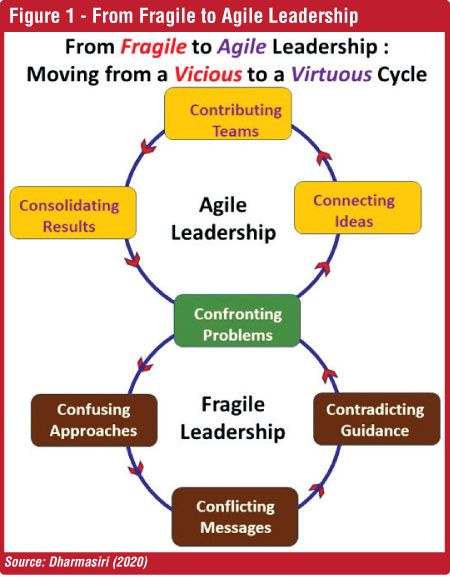Monday Dec 22, 2025
Monday Dec 22, 2025
Monday, 1 August 2022 00:20 - - {{hitsCtrl.values.hits}}

 The suffering from a devastating planetary pandemic is not yet over. We Sri Lankans are experiencing chaotic crises with disappointment and desperation in the common masses. Whilst an insensitive group of so called leaders carry on their priorities, the country is on an agonising path. Some superficially blame it on lack of Dollars in calling it a Dollar crisis. I would rather go beyond in boldly call it a leadership lacuna. That is why I opted to revisit my most-discussed topic in sharing some thoughts on the shift needed from fragile to agile leadership.
The suffering from a devastating planetary pandemic is not yet over. We Sri Lankans are experiencing chaotic crises with disappointment and desperation in the common masses. Whilst an insensitive group of so called leaders carry on their priorities, the country is on an agonising path. Some superficially blame it on lack of Dollars in calling it a Dollar crisis. I would rather go beyond in boldly call it a leadership lacuna. That is why I opted to revisit my most-discussed topic in sharing some thoughts on the shift needed from fragile to agile leadership.
Overview
We experience the repercussions of a clear absence of leadership at the helm. When the need is to be proactive, preventive and persuasive, leaders acting otherwise can have dire consequences. Mismanagement in many fronts without clear accountabilities have only resulted in a blame game with finger pointing at all directions. In fact, I wonder whether we as a nation has failed the true test of leadership.
It reiterates what Rulp Strogdil, a veteran researcher, said so many years ago. “Leadership is a vastly researched but least understood phenomena on earth.” Perhaps the only ship that survives a storm is leadership. It is not about positions and titles, but about decisions and actions. Leadership is essentially a mindset. We look at the leaders at the top but not the “leaders at the tap.”
Dynamics of leadership highlights the leaders and laggards in the society showcasing actions and inactions. Leaders are performers. They practice what they preach. They inspire, influence, and initiate in such a manner to involve in result-oriented action. In contrast, laggards are passengers. They hamper the progress by being lazy and lethargic. Indecisiveness resulting in inaction is often common in their approach. Do we see more leaders or laggards? The answer lies in the results they achieve. It is better to light a candle than curse the darkness. Living with leaders and laggards leave us a less number of choices for lasting results. Leaders must be far more effective to overcome the ineffectiveness of laggards.
From fragile to agile leadership
The term agility is associated with the ability to move with ease. It is the dynamism with its distinct dimensions that is highlighted when it comes to agile leadership. In essence, agile refers mainly to self-organization, quality, delivery, collaboration, and being adaptive to change. In contrast, the fragile leadership, is a term I propose to describe fragmented behaviours that would not pave way for collectively achieving desired results. Agile leadership paves way for development whilst the fragile leadership is the path for decay. Combatting COVID-19 in countries around the globe have shown the evidence for both scenarios.
The current socio-economic crisis with multiple painful consequences is a clarion call for right leadership in taking right decisions resulting in right actions with right outcomes. It requires being proactive then reactive in moving beyond a vicious cycle of fragile leadership to a virtuous cycle of agile leadership. Figure 1 contains the details.
As Figure 1 depicts, the starting point could be confronting problems. It is what leadership is expected to do. As they say, “Calm seas never made a skilled sailor.” As they also say, “Life’s roughest storms prove the strength of our anchors.” The true nature of one’s leadership is revealed when one encounters obstacles and stumbling blocks. Using obstacles as opportunities and stumbling blocks as stepping-stones is the true leadership in action. When it does not happen, a vicious cycle begins to take place, demonstrating fragile leadership.
 Vicious cycle of fragile leadership
Vicious cycle of fragile leadership
Sadly, this is the story with laggards more than the leaders. As we have often observed when there is VUCA 1.0 (Volatility, Uncertainty, Complexity and Ambiguity), the leadership response should be VUCA 2.0 (Vision, Understanding, Confidence and Agility). In the absence of it, we see the evidence for fragile leadership.
When confronting problems, they demonstrate confusing approaches, lacking clarity. It could be a case of a manager of a small company handling a financial fraud by an employee. It could even be a case where Donald Trump prematurely declaring COVID-19 vaccine success, disregarding the advice of medical experts and weird decisions sans consultations. It could perhaps be due to over-reliance of one’s experience and expertise, imprisoned in the bubble of “I know all.”
From confusing approaches, it moves to conflicting messages. We saw this with the mockery of tweeter messages of a world leader who is refusing to accept the election realities. It may be true for fragile leaders at all levels in a typical where the followers are often confused because of the frequent change of standpoints to please higher powers. We have many contradictions in Sri Lankan society with regards to native treatments such as herbal medicines for preventing COVID-19 infection, or to boost one’s immunity.
The next stage is the contradicting guidance where the team members are not clear about the way forward. It damages the coherence and consistency with regards to implementing a key decision with high people implications. We saw many such instances in the combatting of COVID-19 which needs constructive criticism for correction. It brings us back to the same problems being confronted repeatedly, thus trapping into a vicious cycle. Why some countries continuously struggle with COVID-19 with the escalation of cases and fatalities daily could be well explained through such a vicious cycle of fragile leadership.
Virtuous cycle of agile leadership
It may not be easy to break away from the perils of a vicious cycle in moving towards the promises of a virtuous cycle. This is where the agile leadership comes to the forefront. When confronting problems, instead of moving to confusing approaches, agile leadership associates itself with connecting ideas. That is where collective brainstorming takes place in a conducive climate created mainly by the leader. The team members openly share their ideas without fear or favour with the end solution in mind. It may sound utopian in certain political contexts but has been proven in many fields, locally, regionally, and globally like.
From the connecting ideas stage, it naturally moves to contributing teams. Obviously, teams demonstrate synergy. With the holistic and humane approach, a team of a cross-functional nature can perform far better than just a mere group of followers or executers. A planetary pandemic is a perfect opportunity to synergise with multiple expertise with one common aim. Whether we saw that happening to the desired level in the local scene is questionable. The current debacle we are in is a more fitting case in point.
When teams contribute to achieve collectively, the next stage of consolidating results occurs. That completes the virtuous cycle of agile leadership. This is very much in line with what is often called as an agile manifesto: “Build projects around motivated individuals. Give them the environment and support they need and trust them to get the job done.” Now, they are ready to confront new emerging problems, in continuing with the virtuous cycle.
Qualities of agile leadership
In order to ensure the moving within a virtuous cycle, the agile leader must demonstrate key qualities. A recent report published by Deloitte, highlighted five such fundamental qualities associated with an agile leader who must be simultaneously resilient, and results driven.
1.Design from the heart and the head:
In crisis, the hardest things can be the softest things. Resilient leaders are genuinely, sincerely empathetic, walking compassionately in the shoes of employees, customers, and their broader ecosystems. Yet leaders must simultaneously take a hard, rational line to protect financial performance from the invariable softness that accompanies such disruptions.
2. Put the mission first:
Agile, resilient leaders are skilled at triage, able to stabilise their organisations to meet the crisis at hand while finding opportunities amid difficult constraints.
3. Aim for speed over elegance:
Such leaders take decisive action, with courage, based on imperfect information, knowing that expediency is essential.
4. Own the narrative:
Agile, resilient leaders seize the narrative at the outset, being transparent about current realities—including what they do not know—while also painting a compelling picture of the future that inspires others to persevere.
5.Embrace the long view:
Agile, resilient leaders stay focused on the horizon, anticipating the new business models that are likely to emerge and sparking the innovations that will define tomorrow.
As the report further elaborates, a typical crisis plays out over three time frames: respond, in which an organisation deals with the present situation and manages continuity; recover, during which an organisation learns and emerges stronger; and thrive, where the organisation prepares for and shapes the “next normal.” The leaders have the substantial and added responsibility to nimbly consider all the above three, time frames concurrently and allocate resources accordingly.
Behavioural responses required
In order to ensure virtual cycle takes place with agile leadership, a set of specific behavioural responses are essential. A recent E& Y report highlighted them comprehensively.
1.Currently people are stressed, uncertain, and highly attuned to leader emotions. They are looking for calm in the storm. As agile leaders be a steady hand at the wheel. Set a measured tone. Self-regulation is key — as leaders through a difficult time we need to show up at our best for others.
2. The people want to know that you know what they are going through, and that you care. Take their perspective. This is about being empathetic. Take the time to personally care and show that you do by asking questions that reflect what you understand to be each person’s situation and need.
3. They want honest connection with, not a separation from, leaders. They want to see leaders as real people too. Show up as who you are. Be authentically you. Share what you are going through. Be as transparent as you can be. We are letting people into our homes right now.
4. The people feel unfocused, disconnected, less motivated and less productive as they work virtually. Lighten the burden. Start meetings with a personal, creative touch. Help people focus on the work that matters most today. Small words with real meaning can give your team the right amount of hope for a better tomorrow.
5. They need meaning in a time of crisis, more than any other time. It is noisy right now and people need clarity on what is most important. Bring it back to what matters most. Now is the time to concentrate on organisational purpose more frequently.
Way forward
“Never tell people how to do things. Tell them what to do and they will surprise you with their ingenuity,” so said General George Patton, of World War II fame. It is much evident that what we need is agile leadership with a virtuous cycle in all fronts for combatting the current chaotic crises. Instead of being opportunistic and oppressive, what we need is leadership at all key fronts who are responsive to the pulse of the people. With clarity, commitment and care, the agile leaders at all levels should pave way for a prosperous and progressive nation.
(The writer is the immediate past Director of Postgraduate Institute of Management. He can be reached through [email protected], [email protected] or www.ajanthadharmasiri.info.)